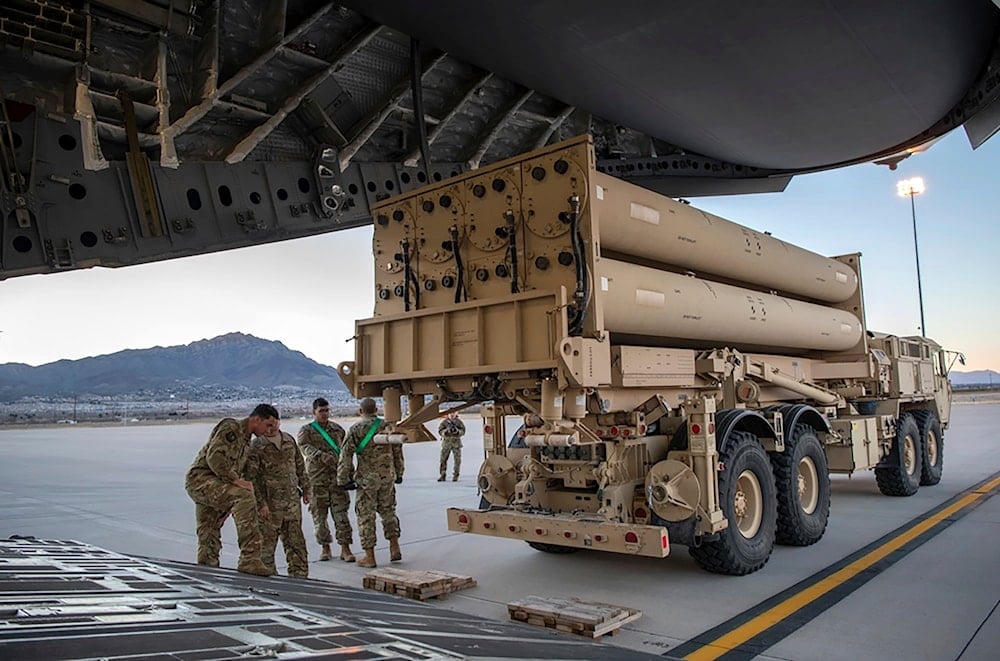US throws itself into THAAD shortage for 'Israel's' sake; 1/4 lost
The US has depleted a quarter of its THAAD interceptor stockpile during "Israel's" war on Iran, raising concerns over missile defense readiness and slow production.
-

This image provided by the US Air Force shows the US Army THAAD launching station preparing to load onto a C-17 Globemaster III at Fort Bliss, Texas, Feb. 23, 2019 (AP)
The United States depleted approximately a quarter of its stockpile of high-end THAAD missile interceptors during "Israel’s" 12-day war on Iran in June, as the interceptors were deployed to counter attacks at a pace that far exceeds their current rate of production, CNN reported, citing two sources familiar with the matter.
According to the sources, US forces responded to Tehran’s large-scale ballistic missile attacks by launching over 100 and potentially as many as 150 THAAD interceptors, accounting for a substantial share of America’s inventory of the sophisticated air defense system. The US operates seven THAAD systems in total and deployed two of them to "Israel" during the war.
The rapid expenditure of so many THAAD interceptors reveals a vulnerability in the US missile defense system and drains a high-value resource at a time when American public support for defending "Israel" has fallen to unprecedented levels.
Slow production poses security risk
According to former US defense officials and missile experts who spoke with CNN, the swift depletion of interceptors has sparked worries about both America’s worldwide military readiness and its capacity to quickly replenish these critical defenses.
According to the Department of Defense's 2026 budget estimates, the US manufactured only 11 new THAAD interceptors last year and is projected to receive just 12 additional ones in the current fiscal year.
When asked about THAAD interceptor usage during the conflict and current US missile defense stockpiles, Pentagon Press Secretary Kingsley Wilson maintained that American forces retain "global operational readiness at all times," claiming Operation Midnight Hammer's success in "neutralizing" Iran's nuclear capabilities as proof of this capability.
According to CNN, a preliminary intelligence assessment found that last month's US strikes on Iranian nuclear facilities failed to eliminate key elements of the program and may have only delayed progress by several months, though the administration rejected these findings.
A defense official, citing operational security considerations, would not disclose details about current THAAD interceptor stockpiles but affirmed that the Pentagon maintains readiness to counter all potential threats.
Massive costs weigh on the US
THAAD is a mobile missile defense system that intercepts short-to-intermediate range ballistic missiles in their final flight phase. Each battery is operated by 95 soldiers and equipped with 48 interceptors manufactured by Lockheed Martin, costing $12.7 million each, according to the 2025 Missile Defence Agency Budget.
According to the Pentagon's 2026 budget projections, the United States intends to purchase 37 THAAD interceptors in the coming year, with partial funding coming from the recent supplemental spending package that President Trump has repeatedly referred to as the "big, beautiful bill".
“The budget includes an additional $1.3 billion for industrial based supply chain improvements, and an additional $2.5 billion for missiles and munitions production expansion,” one US defense officials told CNN, adding, “The Department’s role is to ensure that the President is armed with the best possible military options for any scenario, and all options remain on the table.”
Unsustainable practice
However, experts and former defence officials told CNN that the depletion of THAAD interceptor missiles is concerning, with one missile defense expert saying that while the US commitment to defend "Israel" is significant, the THAAD expenditure is concerning and is not sustainable in the long term, as it remains a scarce resource.
An unnamed retired senior US Army officer revealed that approximately one-quarter of America's THAAD interceptor inventory was deployed by US forces supporting "Israel's" operations, while noting that the Pentagon is now urgently reassessing wartime munitions stockpiles and working to dramatically boost annual production capacity after years of inadequate preparedness.
Four former senior US defense officials indicated that worries about the United States' interceptor stockpiles existed before the recent 12-day war, particularly regarding the critically low levels of advanced interceptors that play a vital role in maintaining deterrence against China.
One official told CNN that he was surprised when he found how long the THAAD stockpiles were, emphasizing that they were dropping, and Washington needs more interceptors, and they need them to be built faster.
Another official emphasized the importance of air defense in modern warfare, stating that there are not enough interceptors in the United States.
'Israel' drains its stockpiles, relies on THAAD
A Jewish Institute for National Security of America (JINSA) analysis found US THAAD and Israeli Arrow systems intercepted 201 of Iran's 574 missiles, with THAAD accounting for nearly half the kills, revealing "Israel's" Arrow stockpile limitations as 57 missiles struck populated areas.
JINSA's data analysis showed declining interception effectiveness as the war progressed, with Iranian missile penetration rates starting at 8% in the first week, increasing to 16% during the second week, and ultimately reaching 25% on the war's final day before the ceasefire took effect.
Missile defense experts observed evident signs of dwindling air defense capabilities, with analysts like Sam Lair of the James Martin Center for Nonproliferation Studies noting that the very deployment of THAAD systems indicated "Israel's" limited interceptor reserves.
Analyst Sam Lair identified 39 THAAD interceptors among 82 advanced missiles in verified social media footage from Jordan, though experts consider this a minimal count. Based on battery deployments, reload capabilities, and the scale of Iran's missile barrage, they estimate US forces likely launched at least 80 THAAD interceptors during the war.
Former defense officials revealed that the Biden administration grew increasingly concerned about diminishing missile defense capabilities in the Indo-Pacific region as substantial portions of the US interceptor stockpile were diverted to counter threats from Yemen's Ansar Allah movement.

 6 Min Read
6 Min Read










